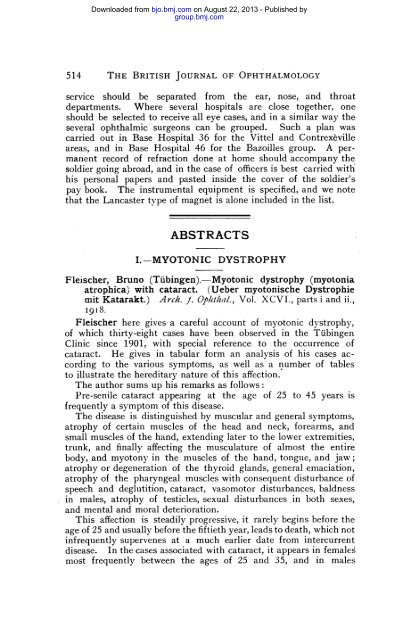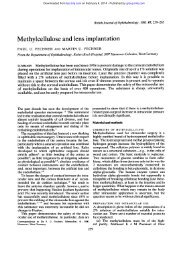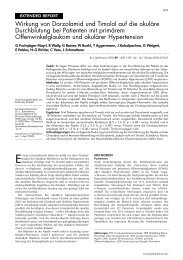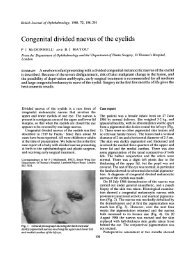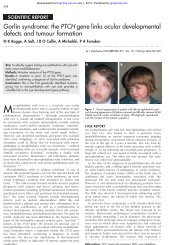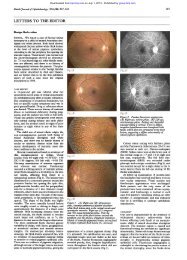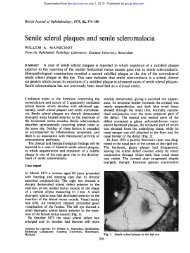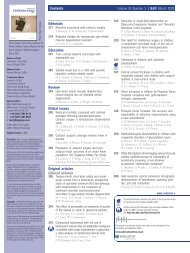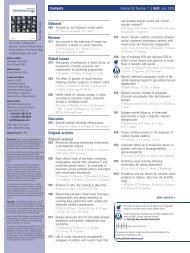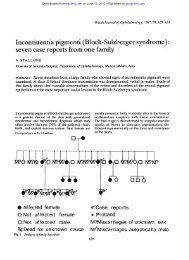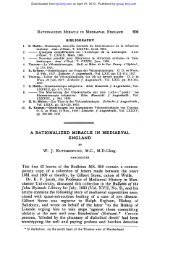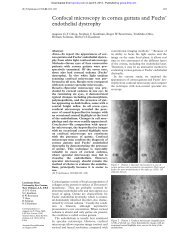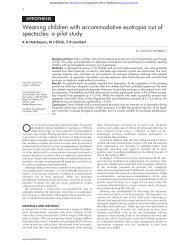ABSTRACTS - British Journal of Ophthalmology
ABSTRACTS - British Journal of Ophthalmology
ABSTRACTS - British Journal of Ophthalmology
You also want an ePaper? Increase the reach of your titles
YUMPU automatically turns print PDFs into web optimized ePapers that Google loves.
Downloaded from bjo.bmj.com on August 22, 2013 - Published by<br />
group.bmj.com<br />
514<br />
THE BRITISH JOURNAL OF OPHTHALMOLOGY<br />
service should be separated from the ear, nose, and throat<br />
departments. Where several hospitals are close together, one<br />
should be selected to receive all eye cases, and in a similar way the<br />
several ophthalmic surgeons can be grouped. Such a plan was<br />
carried out in Base Hospital 36 for the Vittel and Contrexeville<br />
areas, and in Base Hospital 46 for the Bazoilles group. A permanent<br />
record <strong>of</strong> refraction done at home should accompany the<br />
soldier going abroad, and in the case <strong>of</strong> <strong>of</strong>ficers is best carried with<br />
his personal papers and pasted inside the cover <strong>of</strong> the soldier's<br />
pay book. The instrumental equipment is specified, and we note<br />
that the Lancaster type <strong>of</strong> magnet is alone included in the list.<br />
<strong>ABSTRACTS</strong><br />
I.-MYOTONIC DYSTROPHY<br />
Fleischer, Bruno (Tubingen).-Myotonic dystrophy (myotonia<br />
atrophica) with cataract. (Ueber myotonische Dystrophie<br />
mit Katarakt.) Arch. J. Op/a/hAl., Vol. XCVI., pa-ts i and ii.,<br />
I 9 1 8.<br />
Fleischer here gives a careful account <strong>of</strong> myotonic dystrophy,<br />
<strong>of</strong> which thirty-eight cases have been observed in the Ttibingen<br />
Clinic since 1901, with special reference to the occurrence <strong>of</strong><br />
cataract. He gives in tabular form an analysis <strong>of</strong> his cases according<br />
to the various symptoms, as well as a number <strong>of</strong> tables<br />
to illustrate the hereditary nature <strong>of</strong> this affection.<br />
The author sums up his remarks as follows:<br />
Pre-senile cataract appearing at the age <strong>of</strong> 25 to 45 years is<br />
frequently a symptom <strong>of</strong> this disease.<br />
The disease is distinguished by muscular and general symptoms,<br />
atrophy <strong>of</strong> certain muscles <strong>of</strong> the head and neck, forearms, and<br />
small muscles <strong>of</strong> the hand, extending later to the lower extremities,<br />
trunk, and finally affecting the musculature <strong>of</strong> almost the entire<br />
body, and myotony in the muscles <strong>of</strong> the hand, tongue, and jaw;<br />
atrophy or degeneration <strong>of</strong> the thyroid glands, general emaciation,<br />
atrophy <strong>of</strong> the pharyngeal muscles with consequent disturbance <strong>of</strong><br />
speech and deglutition, cataract, vasomotor disturbances, baldness<br />
in males, atrophy <strong>of</strong> testicles, sexual disturbances in both sexes,<br />
and mental and moral deterioration.<br />
This affection is steadily progressive, it rarely begins before the<br />
age <strong>of</strong> 25 and usually before the fiftieth year, leads to death, which not<br />
infrequently supervenes at a much earlier date from intercurrent<br />
disease. In the cases associated with cataract, it appears in females<br />
most frequently between the ages <strong>of</strong> 25 and 35, and in males
Downloaded from bjo.bmj.com on August 22, 2013 - Published by<br />
group.bmj.com<br />
MYOTONIC DYSTROPHY<br />
between 35 and 45. The incipient signs <strong>of</strong> cataract are observed<br />
in the earliest stages <strong>of</strong> the disease.<br />
The examination <strong>of</strong> families has shown that myotonic dystrophy<br />
is a markedly familial hereditary aflection, the germ <strong>of</strong> which can<br />
be traced back for five or six generations. The heredity is homochronous<br />
and homologous. This disease, therefore, belongs to<br />
the group <strong>of</strong> typical familial-hereditary diseases <strong>of</strong> a degenerative<br />
character.<br />
Other signs <strong>of</strong> the disease. in descending series <strong>of</strong> generations<br />
are to be found particularly in the appearance <strong>of</strong> pre-senile cataract,<br />
in the generation preceding the myotonia, without other symptoms<br />
<strong>of</strong> myotonic dystrophy-usually at a more advanced age than in the<br />
phase <strong>of</strong> myotonic degeneration-or sometimnes <strong>of</strong> a simple senile<br />
cataract in still earlier generations. To these may be added an<br />
increased infant mortality, childless marriages, celibacy, so that certain<br />
branches <strong>of</strong> the families die out and hence the disease disappears.<br />
The cataract cannot be regarded as the sign <strong>of</strong> a latent tetany<br />
owing to the difference in its form from that <strong>of</strong> tetany; but, like the<br />
latter, it very probably owes its origin lto an aftection <strong>of</strong> the glands<br />
<strong>of</strong> internal secretions.<br />
(In myotonic dystrophy the cataract begins in the posterior cortex with opacity <strong>of</strong><br />
the posterior pole and radiating striae in the form <strong>of</strong> a star; similar changes then<br />
appear in the anterior cortical layers, accompanied by very fine punctate opacities<br />
throughout the lens substance This condition then develops fairly rapidly into a<br />
complete s<strong>of</strong>t cataract with a small nucleus, corresponding to the age <strong>of</strong> the patients.<br />
In tetany the lens frequently shows a large hard nucleus and the cataract commences<br />
with opacities in a supranuclear zone similar to those found in lamellar<br />
cataract.)<br />
With the probability <strong>of</strong> this origin the appearance <strong>of</strong> cataract,<br />
pre-senile and senile, in earlier generations acquires special significance<br />
for the pathogenesis <strong>of</strong> the disease which, owing to the<br />
presence <strong>of</strong> disturbances <strong>of</strong> internal secretion in conjunction with<br />
dystrophic and myotonic symptoms, is <strong>of</strong> great theoretical interest,<br />
especially when the probability <strong>of</strong> changes in the central nervous<br />
system is taken into consideration. The question <strong>of</strong> the connection<br />
between the disturbances in the glands <strong>of</strong> internal secretion and<br />
the aflection <strong>of</strong> the muscles and probable disease in the central<br />
nervous system must be reserved for further research when the<br />
pathological anatomy <strong>of</strong> this disease has been made clear.<br />
By reason <strong>of</strong> its relation to changes in the glands <strong>of</strong> internal<br />
secretion the cataract <strong>of</strong> myotonic dystrophy is <strong>of</strong> very great<br />
interest for the problem <strong>of</strong> the aetiology <strong>of</strong> cataract in general.<br />
The author appends a long list <strong>of</strong> references to the literature <strong>of</strong><br />
the subject, and shows in several plates photographs illustrative <strong>of</strong><br />
the myotonic facies and other features <strong>of</strong> the disease.<br />
THOMAS SNOWBALL.<br />
515
Downloaded from bjo.bmj.com on August 22, 2013 - Published by<br />
group.bmj.com<br />
516 THE BRITISH JOURNAL OF OPHTHALMOLOGY<br />
II.-MACULAR VISION IN HEMIANOPIA<br />
(i) Van Schevensteen, A.- Traumatic incomplete left homonymous<br />
hemianopsia or quadrant anopsia with conservation<br />
<strong>of</strong> the macular visual fields, and- pure word blindness.<br />
(Hdmianopsie homonyme gauche traumatique incomplete<br />
ou anopsie en quadrant avec conservation des champs<br />
visuels maculaires et c6citd verbale pure.) Ann. d'Oculist.,<br />
June, I9I6.<br />
(1) A. Van Schevensteen, junior, records the case <strong>of</strong> a lefthanded<br />
soldier in whom a fracture <strong>of</strong> the right parieto-occipital<br />
region <strong>of</strong> the skull by a shrapnel bullet was followed by homonymous<br />
hemianopic defects in the left lower quadrants <strong>of</strong> his fields <strong>of</strong> vision.<br />
The macular fields were not involved, and the colour fields within<br />
the areas in which vision was retained were normal. The- injury<br />
caused unconsciousness, and on coming to himself, the patient was<br />
blind. He gradually recovered his sight, but his visual acuity never<br />
got better than O@3 in each eye. The defects in the visual fields<br />
remained unaltered for three months. The patient could recognise<br />
printed or written letters easily, and could read usual words <strong>of</strong> one<br />
or two syllables, but could not understand polysyllabic words or put<br />
a sentence together. The internal visual image <strong>of</strong> words was<br />
retained. In writing he had great difficulty in keeping on the lines.<br />
He copied printed letters one by one, and at the end <strong>of</strong> a couple <strong>of</strong><br />
hours he could only read some one- or two-syllable words in his<br />
copy. As is well known, the cortical centre for the mental representation<br />
<strong>of</strong> ideas in right-handed subjects is situated in the left<br />
hemisphiere,. and word-blindness therefore normally accompanies<br />
injuries <strong>of</strong> the left side <strong>of</strong> the head, and is associated with right<br />
hemianopsias; but in the present case the patient being left-handed<br />
word blindness was caused by a lesion <strong>of</strong> the right side <strong>of</strong> the head,<br />
and was associated with left hemianopsia. The case contrasts with<br />
one previously reported by the author' in which an injury to the<br />
right parieto-occipital region. <strong>of</strong> a right-handed man caused<br />
hemianopic defects in the left lower quadrants without great<br />
difficulty in reading. R. J. COULTER.<br />
(2) Vinsonneau, Angers.-Central vision in hemianopics with<br />
intact macular zone. (La vision maculaire chez les<br />
hdmianopsiques A zone maculaire intacte.) Arch. d'Ophtal.,<br />
September-October, I916.<br />
(2) Cases <strong>of</strong> hemianopia due to wounds <strong>of</strong> the skull by firearms<br />
have attracted the close attention <strong>of</strong> ophthalmologists during the<br />
'Arch. d'OPhtal., 1907, p. 158.
Downloaded from bjo.bmj.com on August 22, 2013 - Published by<br />
group.bmj.com<br />
EYE CHANGES IN TRENCH NEPHRITIS<br />
present war. In a paper published in November, 1915 (Arch.<br />
d'Ophtal., Nov.-Dec., 1915, p. 785), Terrien and Vinsonneau<br />
devoted special attention to the condition <strong>of</strong> central vision in cases<br />
<strong>of</strong> hemianopia due to wounds <strong>of</strong> the skull received in battle. An<br />
unexpected result <strong>of</strong> their investigations, to which they directed<br />
attention, was that in a number <strong>of</strong> observations in cases <strong>of</strong> homonymous<br />
hemianopia with preservation <strong>of</strong> macular vision, the visual<br />
acuity <strong>of</strong> the eye on the same side as the loss <strong>of</strong> field (right eye in<br />
right hemianopia, left eye in left hemianopia) was lowered to a<br />
greater degree than that <strong>of</strong> the eye on the opposite side; in other<br />
words, the eye on the same side as the cranial lesion suffered less<br />
deterioration <strong>of</strong> central vision than did the eye on the opposite<br />
side. A study <strong>of</strong> cases published by others seems to confirm these<br />
observations and the authors propose to deal more fully with all<br />
recorded cases bearing on this symptom after the war. They have<br />
already suggested a possible anatomical explanation <strong>of</strong> the unequal<br />
deterioration <strong>of</strong> vision which thev propose to discuss anew in their<br />
later work. J. B. LAWFORD.<br />
(3) Cerise, L.-Two cases <strong>of</strong> double hemianopia with preservation<br />
<strong>of</strong> macular vision. (Deux cas d'hMmianopsie double<br />
avec conservation de la vision maculaire.) Arc/i. d'Op/i/al.<br />
Septemnber-October, I9I6.<br />
In the meantime Cerise reports two additional cases which<br />
exhibit an inequality <strong>of</strong> central vision in favour <strong>of</strong> the eye on the<br />
side <strong>of</strong> the cerebral lesion. (1) Wound by a shell splinter in the<br />
left upper occipital region. Right homonymous hemianopia: right<br />
eye V.= 4/10, left eye V.= 7/10. (2) WVound by a fragment <strong>of</strong> shell<br />
in the left upper occipital region. Right homonymous hemianopia;<br />
with preservation <strong>of</strong> the macular zone: right eye V.=4/1O, left<br />
eye V.=6/10. J. B. LAWFORD.<br />
517<br />
III.-EYE CHANGES IN<br />
TRENCH NEPHRITIS<br />
Kirk, J. (late R.A.M.C.)- Eye changes in trench nephritis<br />
Brit. Med.Jl., January 5, 1918.<br />
Kirk examined the eyes <strong>of</strong> 70 or 80 cases <strong>of</strong> trench nephritis<br />
chiefly in soldiers between 20 and 30 years <strong>of</strong> age, who for the most<br />
part were seriously ill <strong>of</strong> the disease. As a result <strong>of</strong> examination <strong>of</strong><br />
the eyes the cases were classified by the author in three groups,<br />
A, B, and C. Group A numbered about 21 men, all convalescent,<br />
and in 4 only <strong>of</strong> them (19 %/O) were slight retinal changes foundsmall<br />
spots <strong>of</strong> exudation, a punctate haemorrhage, slight haziness
Downloaded from bjo.bmj.com on August 22, 2013 - Published by<br />
group.bmj.com<br />
518 THE BRITISH JOURNAL OF OPHTHALMOLOGY<br />
<strong>of</strong> the optic disc, or a little oedema along the course <strong>of</strong> the veins.<br />
Group B included about 20 patients, with some albumin in the<br />
urine, breathlessness, and oedema, and <strong>of</strong> these cases 8 (40 o/.)<br />
showed minor retinal changes, but 1 suftered from a somewhat<br />
severe neuro-retinitis. Group C, 13 in -number, had nephritis in<br />
marked form, and <strong>of</strong> these 4 had severe and 4 slighter retinal<br />
changes (61 °/o). As regards the retinal changes Kirk notes that<br />
the spots <strong>of</strong> exudation were near the disc and in the macular region,<br />
although the star-like figuret familiar to ophthalmic surgeons was<br />
not observed; haemorrhages were uncommon; the optic disc was<br />
<strong>of</strong>ten affected; small areas <strong>of</strong> oedema were present along the veins;<br />
and, lastly, the gradual absorption <strong>of</strong> the smaller patches <strong>of</strong> exudation<br />
could be followed in several instances. Kirk sums up by saying<br />
that in trench nephritis the retina is very liable to be involved; that<br />
the changes are probably due to a specific toxin; that the retinal<br />
deposit tends- to clear up in most cases; and that the retinal<br />
condition is allied to the acute retinitis <strong>of</strong> pregnancy, scarlatina, and<br />
acute toxaemia, and should not be confounded with the retinitis <strong>of</strong><br />
cheonic nephritis with its permanent changes in the retinal vessels<br />
and tissues. S. S.<br />
IV.-FLAVINE<br />
Lawson, Arnold (London).- Flavine in Ophthalmic Surgery<br />
Lancet, Jutne 28, 19i9. (Op/tl/al. Soc., May, 19I9).<br />
Ophthalmic surgeons everywhere will be much interested in<br />
Lawson's article upon the use <strong>of</strong> flavine in eye work. It is a clinical<br />
and at the same time a critical article in which the author simply<br />
states his experiences <strong>of</strong> the class <strong>of</strong> case in which this drug is <strong>of</strong><br />
service, and <strong>of</strong> the class <strong>of</strong> case in which it is not.<br />
Flavine is employed in one or two forms, namely acriflavine<br />
(methyl chloride <strong>of</strong> diamino-acridine) and pr<strong>of</strong>lavine (hydrochloride or<br />
sulphate <strong>of</strong> diamino-acridine). Both are potent antiseptics, the<br />
bactericidal action <strong>of</strong> which is enhanced by admixture with serum.<br />
They are comparatively nontoxic both locally and generally. In<br />
concentrated solutions pr<strong>of</strong>lavine is the less irritating and this, in a<br />
standard solution <strong>of</strong> 1 in 1000 normal saline, is what the author has<br />
employed. If, however, the solution is to be used for more than<br />
two or three days this strength becomes slightly irritating and<br />
should be reduced to 1 in 4000. The author divides his experiences<br />
into " Wounds " and " Inflammatory Conditions " <strong>of</strong> the eve. In<br />
this coninection it is pointed out and insisted upon that flavine is to<br />
be regarded rather as an antiseptic than as a disinfectant. It is to
Downloaded from bjo.bmj.com on August 22, 2013 - Published by<br />
group.bmj.com<br />
FLAVINE 519<br />
be used to prevent sepsis rather than to cure it. Consequently its<br />
use in wounds is much more valuable than in inflammatory<br />
conditions. There are four classes <strong>of</strong> wounds in which Lawson<br />
has found flavine " <strong>of</strong> the highest value," namely, wounds caused by<br />
foreign bodies, operations requiring sutures, operations on " dirty"<br />
eyes, and as a dressing for grafts.<br />
With regard to the first heading, the author makes the remarkable<br />
statement that in the two years during which he has employed<br />
flavine he has not met with a single case, coming under early<br />
treatment, which has given rise to trouble on the ground <strong>of</strong> sepsis.<br />
Again, in squiint operations, for example, "troubles with sutures<br />
will vanish if flavine is dropped into the eye immediately after the<br />
operation, and its use steadily continued during the wound healing."<br />
With regard to operations on dirty eyes the author's words may<br />
again be quoted. " Perhaps this point most frequently arises in some<br />
cases <strong>of</strong> perforation <strong>of</strong> the cornea with extrusion <strong>of</strong> the iris and in a<br />
certain number <strong>of</strong> cases <strong>of</strong> acute congestive glaucoma. In both <strong>of</strong><br />
these classes the danger <strong>of</strong> sepsis spreading to the wound edges, and<br />
so to the interior <strong>of</strong> the eye, is, I believe, very sensibly diminished<br />
by the use <strong>of</strong> flavine at the time <strong>of</strong> operation, and. for a couple <strong>of</strong><br />
days or so after the operation. In such cases a solution <strong>of</strong> 1 in<br />
1000 can be safely used and is to be preferred to a weaker one."<br />
With regard to grafts Lawson is also quite specific in his<br />
statement :-" The surface to be grafted, after bleeding has been<br />
stopped, should be well swabbed over with flavine (1 in 1000), and<br />
strips <strong>of</strong> gauze well soaked in flavine should be laid over the graft<br />
when applied. This dressing need not be touched for several da7s.<br />
All that is necessary is to moisten the gauze dressing with fresh<br />
flavine from time to time. In the case <strong>of</strong> Thiersch grafts, where it<br />
is most desirable not to interfere with the graft for at least a week,<br />
I prefer to use for the dressing itself the weaker solution <strong>of</strong> flavine<br />
(1 in 4000) rather than the stronger (1 in 1000), and have found it<br />
perfectly efficacious."<br />
With regard to inflammatory conditions <strong>of</strong> the eye, such as<br />
conjunctivitis, flavine alone is not to be relied upon. It is not a<br />
good disinfectant. It may be used in combination with the usual<br />
remedies. Lawson makes the interesting suggestion that flavine<br />
might be found to be a better and safer prophylactic than silver<br />
nitrate against ophthalmia neonatorum. He has not had an<br />
opportunity <strong>of</strong> testing it in this respect, and if one might <strong>of</strong>fer a<br />
friendly criticism, it is that the sentence " I would commend its<br />
trial to midwives and doctors" is in need <strong>of</strong> emendation. The<br />
author considers, from his personal experience, that the use <strong>of</strong><br />
flavine (1 in 4000) is <strong>of</strong> value in actual ophthalmia neonatorum, in<br />
that it protects the cornea from invasion. He employs a drop <strong>of</strong><br />
the weak solution after each irrigation <strong>of</strong> the eye. In corneal
Downloaded from bjo.bmj.com on August 22, 2013 - Published by<br />
group.bmj.com<br />
520 THE BRITISH JOURNAL OF OPHTHALMOLOGY<br />
ulcerations there is, as a rule, no advantage in the use <strong>of</strong> flavine, but<br />
in hypopyon ulcer a solution <strong>of</strong> flavine can be quite safely used to<br />
wash out the anterior chamber. In relapsing blepharitis an ointment<br />
<strong>of</strong> pr<strong>of</strong>lavine oleate (1 in 1000) had a very good effect in one case,<br />
but the author does not feel justified in making positive statements<br />
as to its use in such conditions.<br />
ERNEST THOMSON.<br />
V.-PREVENTIVE LEGISLATION<br />
(i) Allport, Frank (Chicago).-State legislation concerning wood<br />
alcohol. Ophtulalmology, July, I916.<br />
(1) This is the fourth <strong>of</strong> a series <strong>of</strong> papers by Alilport, dealing<br />
with legislation in the United States in its relation to ophthalmology.<br />
It is now well known that wood alcohol, or methyl alcohol, when<br />
either imbibed or inhaled can produce serious toxic symptoms,<br />
leading to blindness and even to death. Wood alcohol is obtainable<br />
on the market in three forms: (1) in its raw, unpurified form,<br />
which is so foul smelling and disgusting to taste that there is little<br />
danger that it will be used for drinking purposes; (2) denatured,<br />
industrial, or domestic alcohol (our " methylated spirit "), mainly<br />
composed <strong>of</strong> ethyl alcohol, but with enough methyl alcohol added to<br />
render it unfit for consumption; and (3) various forms <strong>of</strong> deodorised<br />
or purified wood alcohol, known as Columbian spirits, Colonial<br />
spirits, etc., from which the odour, taste, and colour <strong>of</strong> wood alcohol<br />
have been removed, but without reduction <strong>of</strong> its intensely poisonous<br />
character.<br />
In the United States especially there have been a large number<br />
<strong>of</strong> cases <strong>of</strong> wood alcohol poisoning due to the internal use <strong>of</strong> one or<br />
other <strong>of</strong> these forms <strong>of</strong> deodorised wood spirits. The danger <strong>of</strong><br />
such an occurrence is much increased by the fact that these are<br />
<strong>of</strong>ten sold without warning as to the poisonous nature <strong>of</strong> the<br />
material and under descriptions which disarm suspicion, for<br />
example: "A pure, refined spirit for domestic use," "A perfect<br />
substitute for grain alcohol." The main point in Allport's paper is<br />
that it is unnecessary to run the risks attached to the use <strong>of</strong> this<br />
substance, since denatured alcohol is equally cheap, is easy to<br />
obtain, and does not involve the same dangers.<br />
Within the last ten years eftorts have been made by legislation<br />
throughout the United States to limit the use <strong>of</strong> wood alcohol.<br />
This paper contains a summary <strong>of</strong> the laws <strong>of</strong> the different States<br />
dealing with the subject. Although these laws are, for the most<br />
part, quite clear, and their intention is well known, it would not be<br />
difficult, as Allport points out, to evade them. He goes so far as to
Downloaded from bjo.bmj.com on August 22, 2013 - Published by<br />
group.bmj.com<br />
HEMIANOPIA IN BRAIN INJURIES<br />
suggest that the manufacture <strong>of</strong> " purified "' wood alcohol should<br />
be stopped, or, if it is indispensable for certain industries, it should<br />
pass straight from the manufacturer to the industry concerned, and<br />
should be kept out <strong>of</strong> the hands <strong>of</strong> retail dealers.<br />
f<br />
A. J. BALLuANTYNE.<br />
(2) Allport, Frank (Chicago).-State legislation concerning shop<br />
lighting, shop accidents, shop conditions, the common towel,<br />
etc. Op/thalmology, October, I9I6.<br />
(2) In this article (the fifth <strong>of</strong> the series), Allport points out that<br />
all measures which prevent disease or injury <strong>of</strong> the eyes in industrial<br />
life are not only beneficial to the workers, but also promote economy<br />
by increasing efficiency and output.<br />
Some <strong>of</strong> the measures to which he draws attention are: suitable and<br />
efficient lighting, provision <strong>of</strong> goggles for protection against foreign<br />
bodies or against excessive heat and light, the fitting <strong>of</strong> protecting<br />
hoods and air suction in connection with grinding wheels, and the<br />
employment <strong>of</strong> secure joints in leather belting. He advocates the<br />
abolition <strong>of</strong> the unskilled " shop oculist," and also speaks in favour<br />
<strong>of</strong> the systematic examination <strong>of</strong> the eyes <strong>of</strong> industrial recruits, and<br />
the fitting, where necessary, <strong>of</strong> correcting glasses.<br />
The second part <strong>of</strong> the paper consists <strong>of</strong> a summary <strong>of</strong> the "shop<br />
laws" <strong>of</strong> the different States <strong>of</strong> the Union, which deal directly or<br />
indirectly with the eyes and eyesight. This contains much<br />
interesting and important matter, but cannot be abstracted.<br />
A. J. BALLANTYNE.<br />
VI.-HEMIANOPIA IN BRAIN INJURIES<br />
Best, F. (Dresden).-Hemianopia and sensory blindness in<br />
brain injuries. (Hemianopsie und Seelenblindheit bei<br />
Hirnverletzungen.) Archz.f. Op/tihal., Vol. XC I II, Part i, I 917.<br />
Best has had the opportunity <strong>of</strong> observing numerous cases <strong>of</strong><br />
head injury in the war in which hemianopia was one <strong>of</strong> the<br />
symptoms. In this lengthy paper he publishes notes <strong>of</strong> several <strong>of</strong><br />
his more interesting observations. He points out the difficulty <strong>of</strong><br />
accurate delineation <strong>of</strong> the fields <strong>of</strong> vision in such patients. The<br />
variations in the fields from day to day may be considerable. His<br />
results may be summed up as follows:<br />
Of his hemianopia cases from war injury, 30-2 per cent. were<br />
double, 25'6 per cent. right sided and 44-2 per cent. left sided;<br />
complete blindness as a result <strong>of</strong> double hemianopia was never<br />
observed. Death occurred in 12,8 per cent. One sided hemianopia<br />
with accurate limit through the fixation point occurred once, with<br />
complete destruction <strong>of</strong> the peripheral field, but preservation <strong>of</strong> the<br />
521
Downloaded from bjo.bmj.com on August 22, 2013 - Published by<br />
group.bmj.com<br />
522 THE BRITISH JOURNAL OF OPHTHALMOLOGY<br />
macula in 3-5 per cent. ; retention <strong>of</strong> the peripheral field with complete<br />
loss <strong>of</strong> the macula, never. These figures refer to cases on<br />
discharge. In recent cases <strong>of</strong> hemianopia the proportion <strong>of</strong> cases<br />
in which the inferior field was affected, 58i1 per cent., was much<br />
greater than those in which the superior field suffered, 5i8 per cent.<br />
Paracentral double scotoma without damage to the peripheral field<br />
occurred in 3i5 per cent., double scotoma with damage to the<br />
peripheral field in 12'8 per cent., macular defect with peripheral<br />
destruction in 25-6 per cent., while in 38,4 per cent. there was only<br />
peripheral defect without scotoma or macular defect. In 18,6 per<br />
cent. the pupil on the aflected side was enlarged, in 7 per cent. that<br />
on the opposite side. In 10-5 per cent. nystagmus, in 4.7 per cent.<br />
abducens paresis, in 2-3 per cent. oculomotor paresis, and in one case<br />
total ophthalmoplegia were found. Incorrect optical localization<br />
regularly accompanies hemianopia. In 31V3 per cent. <strong>of</strong> cases<br />
number counting by eye was defective and in 5-8 per cent. there<br />
was optical agnosis. In 25-6 per cent. alexia and in 14 per cent.<br />
agraphia was present.<br />
In cases <strong>of</strong> hemianopia, which practically always occurs in<br />
injuries <strong>of</strong> the calcarine area, all sight functions in the affected<br />
parts <strong>of</strong> the field are damaged ; there is no evidence <strong>of</strong> a special<br />
colour differentiation centre except in so 'far as sensory disturbances<br />
(aphasic) may be affected. The seat <strong>of</strong> the cerebral centre for<br />
optical localization is in the calcarine area, that for the upper<br />
part <strong>of</strong> the field being situated in the lower part <strong>of</strong> the calcarine<br />
fissure and that for the lower part <strong>of</strong> the field in the upper lip <strong>of</strong> the<br />
fissure. As regards the seat <strong>of</strong> the cerebral macula, Best has no<br />
fresh suggestion to <strong>of</strong>fer, but considers that the theory postulating<br />
a seat for both halves <strong>of</strong> the macula in both hemispheres is highly<br />
improbable, since the escape <strong>of</strong> the macula is not a sharply defined<br />
circumference, but a more or less large remnant <strong>of</strong> a hemiamblyopic<br />
field in which the most important part has retained its function.<br />
The rarity <strong>of</strong> the complete destruction <strong>of</strong> half the field <strong>of</strong> vision is<br />
to be explained by the relatively large area <strong>of</strong> the calcarine, the<br />
destruction <strong>of</strong> the lower part <strong>of</strong> which completely is incompatible<br />
with life, owing to the proximity <strong>of</strong> the cerebellum.<br />
The calcarine area is also the centre for reflex ocular movements,<br />
particularly those connected with fusion and convergence. It is<br />
also the centre for optical localization. Alexia and agraphia seem<br />
to follow more <strong>of</strong>ten left sided injury. In general, both these affections<br />
seem to be indepen^dent and not due to narrowing <strong>of</strong> the field<br />
for letters. Primitive visual injuries (such as number counting)<br />
occur equally in lesions <strong>of</strong> either side, but severe sensory blindness<br />
only in injuries-<strong>of</strong> both sides. E. E. H.
Downloaded from bjo.bmj.com on August 22, 2013 - Published by<br />
group.bmj.com<br />
CONTUSION OF GLOBE AFTER SHOT INJURY<br />
523<br />
VII.-CONTUSION OF GLOBE AFTER SHOT INJURY<br />
Igersheimer (Gottingen).-On the anatomy <strong>of</strong> contusion <strong>of</strong><br />
the globe following shot injury. . (Zur Anatomie der<br />
Contusio Bulbi durch Schussverletzung.) Arch. f. Ophkal.,<br />
Vol. XCIII, Pt. ii, 1917.<br />
Igersheimer's case was a soldier <strong>of</strong> 29, who came under observation<br />
six days after his wound. The wound-<strong>of</strong> entry was on the left<br />
side <strong>of</strong> the forehead, near the hair margin, and that <strong>of</strong> exit near the<br />
right outer canthus. The right upper lid was somewhat swollen<br />
and red, the globe slightly proptosed and the pupil did not react.<br />
The vitreous was obscured by blood, but, when this had been<br />
cleared up, a rupture <strong>of</strong> the choroid concentric with the papilla<br />
became visible. It was also possible, a little later, to make out that<br />
the retina was uneven over the white area and that the vessels were<br />
partly obscured by the white mass. A coloured plate <strong>of</strong> the<br />
ophthalmoscopic appearances is given. Two months after the<br />
injury the man was marked for discharge, when meningitis suddenly<br />
set in and he died. Igersheimer obtained the globe and gives a<br />
minute account <strong>of</strong> its microscopical anatomy, illustrated with three<br />
text drawings.<br />
Histological examination showed that the grey-white<br />
mass seen with the ophthalmoscope was a §ubretinal scar tissue<br />
formation <strong>of</strong> the choroid which had projected in a spur-like way<br />
into the retina. In this area the retina was more or less atrophic.<br />
The choroid was split up in its anterior layers through the formation<br />
<strong>of</strong> scar tissue, and the destruction <strong>of</strong> the choriocapillaris and also to<br />
some extent <strong>of</strong> the large vessel layer, while the suprachoroidea was<br />
well preserved. Whether the proliferation <strong>of</strong> the choroidal. tissue<br />
was the primary affection, and the disturbance <strong>of</strong> the pigment<br />
epithelium and posterior layers <strong>of</strong> the retina the second, or whether<br />
the tear in the pigment epithelium produced the other changes, or<br />
finally, the interference with the ciliary circulation was the underlying<br />
cause <strong>of</strong> all the other changes, could not be determined from<br />
the preparations.<br />
Igersheimer adds a brief account <strong>of</strong> another eye in his possession,<br />
in which the final stages <strong>of</strong> such an injury are demonstrable. He<br />
gives no account <strong>of</strong> the nature <strong>of</strong> the injury in this case, but states,<br />
that careful examination revealed no perforation or external injury.<br />
On one side the iris and ciliary body were normal. On this side<br />
the retina was degenerated near the ora serrata; corresponding<br />
with the degeneration, the pigment epithelium had proliferated.<br />
Then followed a broad band in which retina and pigment epithelium.<br />
were well preserved. Further in, the retinal rods and cones were<br />
lost, and the pigment epithelium became iriegular and wandered<br />
into the retina. Close to the papilla there was a scar between
Downloaded from bjo.bmj.com on August 22, 2013 - Published by<br />
group.bmj.com<br />
524 THE BRITISH JOURNAL OF OPHTHALMOLOGY<br />
retina and choroid, as in the previous case. In the other half <strong>of</strong><br />
the globe the retina was completely destroyed, as also the pigment<br />
epithelium and part <strong>of</strong> the choroid, their place being taken from<br />
the papilla to the ora serrata by scar tissue which was half the<br />
thickness <strong>of</strong> the sclera-and contained scattered pigment. The scar<br />
tissue was separated from the sclera by choroidal remnant$ (cross<br />
section <strong>of</strong> vessels and scattered pigment clumps). In the<br />
neighbourhood <strong>of</strong> the ora serrata the vitreous contained blood clot.<br />
The pigment layer <strong>of</strong> -the ciliary body and iris was also affected,<br />
being partly destroyed and partly scattered through the tissue.<br />
E. E. H.<br />
VIII.-MISCELLANEOUS<br />
(Third Notice)<br />
(i) Lo Cascio (Rome).-The composition <strong>of</strong> the pigment <strong>of</strong><br />
melanotic sarcoma <strong>of</strong> the choroid. (Sulla costituzione del<br />
pigmento del sarcomi melanotici della coroide.) Lat Clin.<br />
Oculist, October, 19I5.<br />
(i) The examination <strong>of</strong> the pigment <strong>of</strong> these tumours hitherto<br />
has been faulty, says Lo Cascio, because the method employed to<br />
extract them has involved alteration <strong>of</strong> their composition. He<br />
thinks that he has been able to remove the pigment without<br />
disturbing it by means <strong>of</strong> copious wtashing with distilled water<br />
containing a few drops <strong>of</strong> chlor<strong>of</strong>orm.<br />
He finds the percentage as follows:<br />
C. 53-17 per cent. H. 616 per cent. N. 12'40 per cent. S.<br />
2,53 per cent. Fe. 0152 per cent. P. 0294 per cent.<br />
This agrees closely with the composition <strong>of</strong> the retinal and<br />
choroidal pigments <strong>of</strong> the normal eye, which two have been shown<br />
by Lo Cascio to be identical.<br />
C. 54.45 per cent. H. 5,88 per cent. N. 12-35 per cent.<br />
0. 26'08 per cent. S. 1-77 per cent. P. 0251 per cent. Fe. 0-101<br />
per cent.<br />
The small differences may be due to experimental errors.<br />
HAROLD GRIMSDALE.<br />
(2) Lamb, Robert Scott (Washington).-Cyanosis retinae et<br />
conjunctivae in connection with pulmonary stenosis and<br />
patent ductus arteriosus. Tralns. A nei. Oplath. Soczety,<br />
Vol. XIV, Part ii, I9I6.<br />
(2) Lamb reports cyanosis <strong>of</strong> the conjunctiva and retina in a<br />
coloured girl, aged 13 years, believed to be aflected with pulmonary
Downloaded from bjo.bmj.com on August 22, 2013 - Published by<br />
group.bmj.com<br />
MISCELLANEOUS<br />
stenosis and patent ductus arteriosus <strong>of</strong> congenital origin. The<br />
condition <strong>of</strong> the retinal vessels is shown by two coloured plates.<br />
The vessels, as usual in such cases, were very tortuous and much<br />
dilated; the distinction between arteries and veins could be readily<br />
made.<br />
The palpebral conjunctiva was almost purple, and the bulbar<br />
conjunctiva was congested. The author mnakes some references to<br />
the literature <strong>of</strong> the condition. S. S.<br />
(3) Rochon-Duvigneaud, A. (Paris).-The protection <strong>of</strong> the<br />
cornea in crawling vertebrates (serpents and anguiliform<br />
fishes). [La protection de la corn6e chez les vert6br6s qui<br />
rampent (serpents et poissons anguiformes).] Ann. d'Ocul.,<br />
May, I916.<br />
(3) A. Rochon-Duvigneaud has studied the manner in which<br />
the corneae <strong>of</strong> serpents and anguiliform fish are protected. He finds<br />
that serpents have in front <strong>of</strong> the cornea a kind <strong>of</strong> watch glass<br />
formed by a transformation <strong>of</strong> the lower lid which has become<br />
fixed in front <strong>of</strong> the eye and transparent. There is a modified<br />
conjunctival sac between the cornea and the " watch glass," which<br />
latter is shed with the slough. In anguiliform fish (eels, etc.) a<br />
similar kind <strong>of</strong> protection is developed in a different way. In them<br />
the cornea consists <strong>of</strong> a superficial thick layer continuous with the<br />
skin and a deep thin layer continuous with the sclerotic between<br />
which there is a loose tissue consisting <strong>of</strong> parallel non-anastomosing<br />
fibres which functions as an intra-corneal articulation allowing the<br />
globe to be moved by its muscles under the cutaneous layer <strong>of</strong> the<br />
cornea which forms its protecting layer. There is no conjunctival sac.<br />
R. J. COULTER.<br />
(4) Leenbeer, C. A. (Chicago). - An orbital endothelioma.<br />
Ophthzal. Record, May, I9I6.<br />
(4) Leenbeer has reported on this case <strong>of</strong> orbital endothelioma<br />
on two previous occasions. After removal <strong>of</strong> the tumour by<br />
Kronlein's orbital resection in 1905, the growth recurred. After<br />
1906, and although it apparently never became larger than it was<br />
at the time it was excised, and never gave the patient any trouble,<br />
the eye and orbital contents were exenterated in 1915. The<br />
histological examination showed that the, growth was a perivascular<br />
endothelioma.<br />
The author's conclusions from this case are that: endotheliomata<br />
<strong>of</strong> the orbit are <strong>of</strong> slow growth and painless. They are prone to<br />
return at the site <strong>of</strong> the operation; but the neighbouring lymph<br />
nodes are not affected early.<br />
Apparently, the growth was primarily one affecting the optic<br />
nerve or its sheath, but the writer does not say so.<br />
J. JAMESON EVANS.<br />
525
Downloaded from bjo.bmj.com on August 22, 2013 - Published by<br />
group.bmj.com<br />
526 THE BRITISH JOURNAL OF OPHTHALMOLOGY<br />
(5) Ferree, C. E. and Rand (Bryn Mawr College).-A rnsum=<br />
<strong>of</strong> experiments on the effects <strong>of</strong> different conditions <strong>of</strong><br />
lighting on the eyes. Alin. <strong>of</strong> Op/tLU., Vol. XXV, No. 3,<br />
July, I916.<br />
(5) The object <strong>of</strong> the work by Ferree and Rand was to compare<br />
the effect <strong>of</strong> the diflerent lighting conditions on the eye, and to<br />
find the factors in a lighting situation, which cause the eve to lose<br />
in efficiency and to experience discomfort. The paper mainly<br />
concerns itself with what are spolken <strong>of</strong> as the " distribution factors,"<br />
viz., the evenness <strong>of</strong> illumination, the diftuseness <strong>of</strong> the light, the<br />
angle at which the light falls on the object viewed, and the evenness<br />
<strong>of</strong> surface brightness. The best control <strong>of</strong> these factors is got<br />
when dealing with a room properly lit by daylight; the next best,<br />
when an indirect system <strong>of</strong> artificial lighting is employed. The<br />
direct and semi-indirect systems are also considered. The investigations<br />
were by no means abstract in character. All the variations<br />
obtained were got by employing lighting installations in common<br />
use, and precise specifications <strong>of</strong> illumination efiects were made in<br />
each case. The conclusions arrived at may be very shortly summarised.-(1)<br />
The influence <strong>of</strong> the distribution factors is <strong>of</strong> the<br />
greatest importance. (2) In the direct and setni-indirect systems<br />
too much light is <strong>of</strong>ten used for the comfort and welfare <strong>of</strong> the eye.<br />
(3) The angle at which the light falls on the object is important,<br />
but is not nearly so important as evenness <strong>of</strong> the surface-brightness in<br />
the field <strong>of</strong> vision. (4) Of the systems <strong>of</strong> artificial lighting, that<br />
which runs the indirect method closest is the semi-indirect with<br />
reflectors having a high density. (5) The problem <strong>of</strong> installation is<br />
not so simple for the semi-indirect as for the wholly indirect<br />
reflectors. (6) The most difficult feature in the problem <strong>of</strong><br />
protecting the eye is encountered in the lighting <strong>of</strong> rooms <strong>of</strong> low and<br />
medium height. (7) The loss <strong>of</strong> efficienc) sustained by the eye in<br />
an unfavourable light seems to be muscular, and not retinal.<br />
(8) Eye shades are not an adequate substitute for lamp shades.<br />
(9) The observation <strong>of</strong> motion-pictures causes the eye to lose<br />
heavily in efficiency, and (10) there is a close relationship between<br />
loss <strong>of</strong> visual efficiency and ocular discomfort. R. H. ELLIOT.<br />
(6) Shahan, William E., and Lamb, Harvey D. (St. Louis) -<br />
Histologic effects <strong>of</strong> heat on the eye. Ainerican <strong>Journal</strong> <strong>of</strong><br />
Op/ittlmiiology, August, I916.<br />
(6) Shahan and Lamb have experimented on the rabbit eye with<br />
the view <strong>of</strong> determining the effects <strong>of</strong> heat applied to the cornea.<br />
,This was done by means <strong>of</strong> a "thermophor." The thermophor<br />
is a metal tube containing a thermometer and surrounded by a<br />
resistance coil to generate heat, while within the coil is placed a
Downloaded from bjo.bmj.com on August 22, 2013 - Published by<br />
group.bmj.com<br />
N OTES<br />
zinc-iron sensitive strip to permit the temperature to be kept at any<br />
constant point. Into one end <strong>of</strong> the metal tube are inserted<br />
applicators <strong>of</strong> various shapes to be applied directly to the cornea<br />
(See <strong>Journal</strong> o-f the American Medical Association, August 5, 1916).<br />
In all the experiments, five in number, the applicator had a<br />
diameter <strong>of</strong> 7 mm. and, in all, the time <strong>of</strong> application was ten<br />
minutes, but the degree <strong>of</strong> heat varied from 119 to 136 degrees<br />
Fahrenheit. The anatomical findings in detail must be sought in<br />
the otiginal. The following are the authors' conclusions.<br />
" We might, therefore, conclude from our findings that the<br />
immediate efiects <strong>of</strong> the heated applicator upon a rabbit's eye are<br />
first a swelling <strong>of</strong> the heated portion <strong>of</strong> the cornea due to a localized<br />
oedema, which with increase <strong>of</strong> heat is accompanied by destruction<br />
<strong>of</strong> the anterior epithelium, then a destruction <strong>of</strong> the posterior<br />
endothelial layer, further by a coagulation necrosis <strong>of</strong> Bowman's<br />
membrane and anterior layers <strong>of</strong> the substantia propria <strong>of</strong> -the<br />
cornea, and lastly a swelling and coagulation necrosis <strong>of</strong> the iris.<br />
Later effects are: first, the appearance <strong>of</strong> the infiltration <strong>of</strong> the<br />
anterior layers <strong>of</strong> the cornea with polymorphonuclear leucocytes,<br />
then the formation <strong>of</strong> scar tissue and new blood-vessels to replace<br />
the destroyed substantia propria <strong>of</strong> the cornea. Lastly, the new<br />
connective tissue with its round pigment cells, where before was<br />
iris stroma." ERNEST THOMSON.<br />
527<br />
NOTES<br />
CAPTAIN R. S. KENNEDY, R.A.M.C., was<br />
Deaths. killed upon the field <strong>of</strong> honour in France in<br />
1918.<br />
Azer Wahba, a prominent member <strong>of</strong> the Ophthalmological<br />
Society <strong>of</strong> Egypt, who was in charge <strong>of</strong> Ophthalmic Hospital at<br />
Zagazig, died suddenly in June last, at the age <strong>of</strong> 34 years.<br />
Henry G. S. Warren, assistant ophthalmic surgeon, Royal<br />
Prince Alfred Hospital, died recently at Sydney, Australia.<br />
Mortimer Frank, <strong>of</strong> Chicago, died on April 21, 1919, at the age<br />
<strong>of</strong> 45. He was ophthalmologist to the Michael Reese and to other<br />
hospitals. In matters <strong>of</strong> medical history he was an authority, and<br />
his library <strong>of</strong> rare medical books and engravings was extensive.<br />
Frank van Fleet, <strong>of</strong> New York, died suddenly on April 5, 1919,<br />
at the age <strong>of</strong> 59. He was surgeon to the Manhattan Eye, Ear,<br />
and Throat Hospital.
Downloaded from bjo.bmj.com on August 22, 2013 - Published by<br />
group.bmj.com<br />
<strong>ABSTRACTS</strong><br />
Br J Ophthalmol 1919 3: 514-527<br />
doi: 10.1136/bjo.3.11.514<br />
Updated information and services<br />
can be found at:<br />
http://bjo.bmj.com/content/3/11/514.citation<br />
Email alerting<br />
service<br />
These include:<br />
Receive free email alerts when<br />
new articles cite this article. Sign<br />
up in the box at the top right corner<br />
<strong>of</strong> the online article.<br />
Notes<br />
To request permissions go to:<br />
http://group.bmj.com/group/rights-licensing/permissions<br />
To order reprints go to:<br />
http://journals.bmj.com/cgi/reprintform<br />
To subscribe to BMJ go to:<br />
http://group.bmj.com/subscribe/


